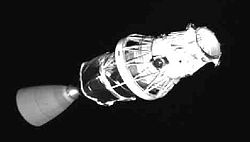 XSS-10 computer model | |
| Mission type | Technology |
|---|---|
| Operator | AFRL |
| COSPAR ID | 2003-005B |
| SATCAT no. | 27664 |
| Spacecraft properties | |
| Manufacturer | Boeing |
| Launch mass | 28 kilograms (62 lb) |
| Start of mission | |
| Launch date | January 29, 2003, 18:06:00 UTC |
| Rocket | Delta II 7925-9.5 (Delta 295) |
| Launch site | Cape Canaveral SLC-17B |
| Orbital parameters | |
| Reference system | Geocentric |
| Regime | Low Earth |
| Eccentricity | 0.020384971 |
| Perigee altitude | 518.0 kilometers (321.9 mi) |
| Apogee altitude | 805.0 kilometers (500.2 mi) |
| Inclination | 39.75 degrees |
| Period | 98.0 minutes |
| Epoch | 29 January 2003, 13:06:00 UTC [1] |
XSS-10 (eXperimental Small Satellite 10) was a small, low-cost micro-spacecraft developed by the U.S. Air Force Research Laboratory's Space Vehicles Directorate to test technology for line-of-sight guidance of spacecraft. [2] The project was initiated at AFRL by Program Manager David Barnhart [3] and completed by Georgia Tech Research Institute engineer Thom Davis and team. [4] The project was declared a success shortly after launch. [5]
